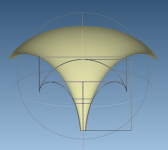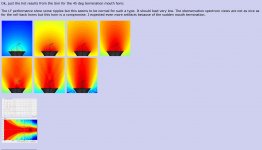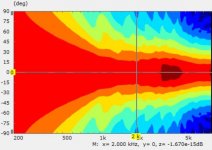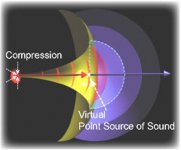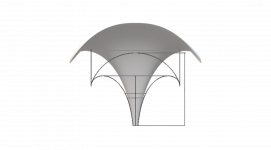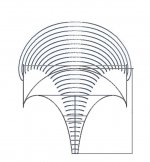A roll-back can be added but this also increases the mouth footprint:
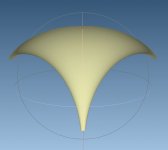
View attachment drba_jmlc_hvdiff_rb.zip

View attachment drba_jmlc_hvdiff_rb.zip
Here is another try to hit camplos requirements. It is complete different approach with an algorith inspired by JMLC and using diffenrent progressive expansion T functions for horizontal and vertical:
View attachment 797385 View attachment 797386
View attachment 797387
As you know =) these dimensions are satisfactory. This is easily the perfect horn for me to cross at 300hz, in theory. Maybe when Don gets a chance, he can run sims.
Devils Advocate.....without breaking the 300hz or lower request. Is this the horn you would choose? Why or why not. The drba_Shark_RA_45_PE_PRJ @ drba_Jericho_45_PE (pg 449) are not exactly miles away from ideal...is there anything that we haven't tried that is worth the effort, like the round overs on the lip. The original Jericho is really close, but suffers from the diffraction, would the radius on the lip fix the diffraction on the lip here too?
This is directed towards who ever is inclined to answer... YouTube
Last edited:
For a "rough comparison" I overlaid docali's latest horn with the profile of an original Iwata.
I've tried to match the throat sizes by rescaling the Iwata, there's probably a few percent difference left, but it's close enough.
Iwata developed his horns according to the principle of "linear expansion".
I've tried to match the throat sizes by rescaling the Iwata, there's probably a few percent difference left, but it's close enough.
Iwata developed his horns according to the principle of "linear expansion".
Attachments
Last edited:
I'm trying to measure the horns length in Fusion and I can only measure from points on the model....cause I don't know any other way yet.....but....its not as long as I thought. I thought it was 31" and it seems to be less than that....I would like to see a longer version for sure.
Spot the speaker
It's a large, but not a huge horn, judged by the dimensions of the Iwata, which is relatively small (about the same width as an Arai 480, only longer).
My brother showed me an article in an interior design magazine.
A former London stable has been converted into a 40m² apartment. The owner, sitting on the steps, is a neurologist who obviously appreciates audio.
It's a large, but not a huge horn, judged by the dimensions of the Iwata, which is relatively small (about the same width as an Arai 480, only longer).
My brother showed me an article in an interior design magazine.
A former London stable has been converted into a 40m² apartment. The owner, sitting on the steps, is a neurologist who obviously appreciates audio.
Attachments
Last edited:
The last horn Docali (first version without roll over) is about 31" long and 35" wide, 21" tall.....I bet the polar will be good on this one.
I've been looking at the polars of the first Jericho....I mean for a "work" horn this might, work. =/ It wouldn't be for casual listening, but for studio purpose. I was hoping he could get rid of the hot spot below 5khz but all in all, this might not be a horrible horn for a one man show...I dunno...I am trying to let go my dream of the 200hz crossover. 300hz isn't so far off....if the frequency response isn't great for the Hvdiff I should probably look at a round horn. I think this horn will have a FR better than the iwata. Gj Docali!
I've been looking at the polars of the first Jericho....I mean for a "work" horn this might, work. =/ It wouldn't be for casual listening, but for studio purpose. I was hoping he could get rid of the hot spot below 5khz but all in all, this might not be a horrible horn for a one man show...I dunno...I am trying to let go my dream of the 200hz crossover. 300hz isn't so far off....if the frequency response isn't great for the Hvdiff I should probably look at a round horn. I think this horn will have a FR better than the iwata. Gj Docali!
Attachments
Last edited:
I found a picture depicting what I was trying to describe in the spiel I gave on how a horn works, and the pressure front that is created by horn loading. Its like the horn is a wide band tuned pipe causing the signals, source size, to increase to that of or near the diameter of the horn.
Attachments
This works up to the frequency at which the horn starts to beam.
The horn in the picture isn't very different from docali's horns, an Iwata, JMLC etc.
The horn in the picture isn't very different from docali's horns, an Iwata, JMLC etc.
For a "rough comparison" I overlaid docali's latest horn with the profile of an original Iwata.
I've tried to match the throat sizes by rescaling the Iwata, there's probably a few percent difference left, but it's close enough.
Iwata developed his horns according to the principle of "linear expansion".
Very interesting comparison! Ma approach was programed from scratch adding "the missing conical section" following a virtual construction wave front and a given expansion function as reference. This work was inspired by JMLC.
What we see here is a version as before but with more roll-back and super ellipse exponent.
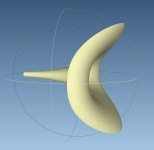
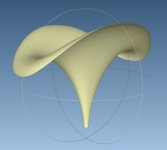
View attachment drba_jmlc_hvdiff_rb2.zip
This horn should show a better observation field but also a considerably larger mouth.
I found a picture depicting what I was trying to describe in the spiel I gave on how a horn works, and the pressure front that is created by horn loading. Its like the horn is a wide band tuned pipe causing the signals, source size, to increase to that of or near the diameter of the horn.
This picture is quite similar to the spherical wave horn approach with constant construction vector length.
The last horn Docali (first version without roll over) is about 31" long and 35" wide, 21" tall.....I bet the polar will be good on this one.
I've been looking at the polars of the first Jericho....I mean for a "work" horn this might, work. =/ It wouldn't be for casual listening, but for studio purpose. I was hoping he could get rid of the hot spot below 5khz but all in all, this might not be a horrible horn for a one man show...I dunno...I am trying to let go my dream of the 200hz crossover. 300hz isn't so far off....if the frequency response isn't great for the Hvdiff I should probably look at a round horn. I think this horn will have a FR better than the iwata. Gj Docali!
I have already started to discuss edge diffraction issues with Don. These terminated mouth horns could be improved to a certain degree. As we see that a generous roll-back improve things much we could add something like a mini roll-back or lip to a terminated mouth horn like this here:
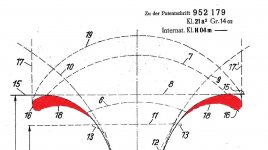
Consistent Modification of the Spherical Wave Horn – Sphericalhorns
This could be added by CAD software.
Good stuff, I am starting to envision some assumptions, horns for certain common fc have similar circumferences...a horn with a ~200hz fc has a size that I can work with. With a generally elliptical shape we are able to get a better horizontal polar but more importantly for me, I can have a larger horn without it being so tall. The progressive T improves the polar and weakens loading, a happy median has to found for each design.
I seek two horns, one where loading is end all goal, one where a desirable polar can take precedence . The shark RA45 with the lip doctored up could turn out to be a really nice horn. I haven’t taken a look at it’s dimensions yet but this horn might give better loading than the JMLC HVDiff. The first Jericho is the only horn that is “truly” loading at 200hz, just saying. I bet the doctored lip and maybe a tweak or two will do the trick for it.
I was thinking about the question I was asked about why crossing low. I spoke of trying to get all I can into the horn, as well as crossing within the Schroeder bands and getting most off the vocal range into one driver but there was also another aspect. KA of the mid woofer. The lower I can get the KA to be on the 15” the more I can focus on positioning the horn while not having to worry about hearing the 15”, uncompressed, at closer or various approximations.
Docali we are close! Ty and Don so much!
I seek two horns, one where loading is end all goal, one where a desirable polar can take precedence . The shark RA45 with the lip doctored up could turn out to be a really nice horn. I haven’t taken a look at it’s dimensions yet but this horn might give better loading than the JMLC HVDiff. The first Jericho is the only horn that is “truly” loading at 200hz, just saying. I bet the doctored lip and maybe a tweak or two will do the trick for it.
I was thinking about the question I was asked about why crossing low. I spoke of trying to get all I can into the horn, as well as crossing within the Schroeder bands and getting most off the vocal range into one driver but there was also another aspect. KA of the mid woofer. The lower I can get the KA to be on the 15” the more I can focus on positioning the horn while not having to worry about hearing the 15”, uncompressed, at closer or various approximations.
Docali we are close! Ty and Don so much!
Last edited:
docali's drba_jmlf_hcdiff_rb2, overlaid with the Iwata profile is a near 100% fit at the throat > verified at pixel level.
The difference between the rollback of the drba and the Iwata is more or less similar to the red-colored area in the patent image posted by docali.
The difference between the rollback of the drba and the Iwata is more or less similar to the red-colored area in the patent image posted by docali.
Attachments
Last edited:
docali's drba_jmlf_hcdiff_rb2, overlaid with the Iwata profile is a near 100% fit at the throat > verified at pixel level.
The difference between the rollback of the drba and the Iwata is more or less similar to the red-colored area in the patent image posted by docali.
All horns based on an exponential expansion equation have similar throat regions.
Btw, these are the corresponding construction wave-fronts:
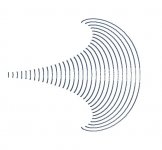
Indeed, it's funny how the throats line up, everytime I drop the Iwata overlay on top of your horns (without any further adjustments after the initial scaling).
I suppose those are the projected "vertical" wavefronts, as "observed" from the side of horn?
It's obvious the expansion is limited compared to the earlier "top-views".
I suppose those are the projected "vertical" wavefronts, as "observed" from the side of horn?
It's obvious the expansion is limited compared to the earlier "top-views".
Attachments
Last edited:
Indeed, it's funny how the throats line up, everytime I drop the Iwata overlay on top of your horns (without any further adjustments after the initial scaling).
I suppose those are the projected "vertical" wavefronts, as "observed" from the side of horn?
It's obvious the expansion is limited compared to the earlier "top-views".
These are the horizontal expansion. The wave-fronts itself are circular for the calculation. Only one cut plane is shown in 2D.
That one cut plane is the horizontal?
Do you mean it's the cross-section of the horizontal expansion, and therefore the wavefronts in #4535 are actually "observed" from the (cross-sectional) right side of the horn, as suggested by its position?
Do you mean it's the cross-section of the horizontal expansion, and therefore the wavefronts in #4535 are actually "observed" from the (cross-sectional) right side of the horn, as suggested by its position?
If you're the hands-on type, looking for a succinct and to the point build thread (by a compatriot fwiw), there you go!
Last edited:
- Home
- Loudspeakers
- Multi-Way
- Is it possible to cover the whole spectrum, high SPL, low distortion with a 2-way?
